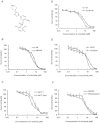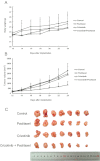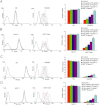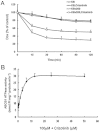Crizotinib (PF-02341066) reverses multidrug resistance in cancer cells by inhibiting the function of P-glycoprotein
- PMID: 22233293
- PMCID: PMC3419910
- DOI: 10.1111/j.1476-5381.2012.01849.x
Crizotinib (PF-02341066) reverses multidrug resistance in cancer cells by inhibiting the function of P-glycoprotein
Abstract
Background and purpose: Besides targeting the well-known oncogenic c-Met, crizotinib is the first oral tyrosine kinase inhibitor inhibiting anaplastic lymphoma kinase (ALK) in clinical trials for the treatment of non-small cell lung cancer. Here, we assessed the possible reversal of multidrug resistance (MDR) by crizotinib in vitro and in vivo.
Experimental approach: 1-(4,5-Dimethylthiazol-2-yl)-3,5- diphenylformazan was used in vitro and xenografts in nude mice were used in vivo to investigate reversal of MDR by crizotinib. To understand the mechanisms for MDR reversal, the alterations of intracellular doxorubicin or rhodamine 123 accumulation, doxorubicin efflux, ABCB1 expression level, ATPase activity of ABCB1 and crizotinib-induced c-Met, Akt and ERK1/2 phosphorylation were examined.
Key results: Crizotinib significantly enhanced the cytotoxicity of chemotherapeutic agents which are also ABCB1 substrates, in MDR cells with no effect found on sensitive cells in vitro and in vivo. Additionally, crizotinib significantly increased intracellular accumulation of rhodamine 123 and doxorubicin and inhibited the drug efflux in ABCB1-overexpressing MDR cells. Further studies showed that crizotinib enhanced the ATPase activity of ABCB1 in a concentration-dependent manner. However, expression of ABCB1 was not affected, and reversal of MDR by crizotinib was not related to the phosphorylation of c-Met, Akt or ERK1/2. Importantly, crizotinib significantly enhanced the effect of paclitaxel against KBv200 cell xenografts in nude mice.
Conclusions and implications: Crizotinib reversed ABCB1-mediated MDR by inhibiting ABCB1 transport function without affecting ABCB1 expression or blocking the Akt or ERK1/2 pathways. These findings are useful for planning combination chemotherapy of crizotinib with conventional chemotherapeutic drugs.
© 2012 The Authors. British Journal of Pharmacology © 2012 The British Pharmacological Society.
Figures






Similar articles
-
Apatinib (YN968D1) reverses multidrug resistance by inhibiting the efflux function of multiple ATP-binding cassette transporters.Cancer Res. 2010 Oct 15;70(20):7981-91. doi: 10.1158/0008-5472.CAN-10-0111. Epub 2010 Sep 28. Cancer Res. 2010. PMID: 20876799 Free PMC article.
-
Lapatinib (Tykerb, GW572016) reverses multidrug resistance in cancer cells by inhibiting the activity of ATP-binding cassette subfamily B member 1 and G member 2.Cancer Res. 2008 Oct 1;68(19):7905-14. doi: 10.1158/0008-5472.CAN-08-0499. Cancer Res. 2008. PMID: 18829547 Free PMC article.
-
BIRB796, the inhibitor of p38 mitogen-activated protein kinase, enhances the efficacy of chemotherapeutic agents in ABCB1 overexpression cells.PLoS One. 2013;8(1):e54181. doi: 10.1371/journal.pone.0054181. Epub 2013 Jan 18. PLoS One. 2013. PMID: 23349819 Free PMC article.
-
Crizotinib, a small-molecule dual inhibitor of the c-Met and ALK receptor tyrosine kinases.Curr Opin Investig Drugs. 2010 Dec;11(12):1477-90. Curr Opin Investig Drugs. 2010. PMID: 21154129 Review.
-
Discovery and biological evaluation of hederagenin derivatives as non-substrate inhibitors of P-glycoprotein-mediated multidrug resistance.Eur J Med Chem. 2025 May 5;289:117428. doi: 10.1016/j.ejmech.2025.117428. Epub 2025 Feb 20. Eur J Med Chem. 2025. PMID: 40010272 Review.
Cited by
-
Synthesis and Pharmacological In Vitro Investigations of Novel Shikonin Derivatives with a Special Focus on Cyclopropane Bearing Derivatives.Int J Mol Sci. 2021 Mar 9;22(5):2774. doi: 10.3390/ijms22052774. Int J Mol Sci. 2021. PMID: 33803437 Free PMC article.
-
The translocator protein (TSPO) ligand PK11195 induces apoptosis and cell cycle arrest and sensitizes to chemotherapy treatment in pre- and post-relapse neuroblastoma cell lines.Cancer Biol Ther. 2013 Apr;14(4):319-26. doi: 10.4161/cbt.23613. Epub 2013 Jan 28. Cancer Biol Ther. 2013. PMID: 23358477 Free PMC article.
-
Efficacy, safety and pharmacokinetics of Unecritinib (TQ-B3101) for patients with ROS1 positive advanced non-small cell lung cancer: a Phase I/II Trial.Signal Transduct Target Ther. 2023 Jun 30;8(1):249. doi: 10.1038/s41392-023-01454-z. Signal Transduct Target Ther. 2023. PMID: 37385995 Free PMC article. Clinical Trial.
-
Resistance to nanoparticle albumin-bound paclitaxel is mediated by ABCB1 in urothelial cancer cells.Oncol Lett. 2017 Jun;13(6):4085-4092. doi: 10.3892/ol.2017.5986. Epub 2017 Apr 5. Oncol Lett. 2017. PMID: 28599410 Free PMC article.
-
Rociletinib (CO-1686) enhanced the efficacy of chemotherapeutic agents in ABCG2-overexpressing cancer cells in vitro and in vivo.Acta Pharm Sin B. 2020 May;10(5):799-811. doi: 10.1016/j.apsb.2020.01.008. Epub 2020 Jan 26. Acta Pharm Sin B. 2020. PMID: 32528828 Free PMC article.
References
-
- Ambudkar SV, Dey S, Hrycyna CA, Ramachandra M, Pastan I, Gottesman MM. Biochemical, cellular, and pharmacological aspects of the multidrug transporter. Annu Rev Pharmacol Toxicol. 1999;39:361–398. - PubMed
-
- Azam M, Latek RR, Daley GQ. Mechanisms of autoinhibition and STI-571/imatinib resistance revealed by mutagenesis of BCR-ABL. Cell. 2003;112:831–843. - PubMed
-
- Bakos E, Homolya L. Portrait of multifaceted transporter, the multidrug resistance-associated protein 1 (MRP1/ABCC1) Pflugers Arch. 2007;453:621–641. - PubMed
-
- Blume-Jensen P, Hunter T. Oncogenic kinase signalling. Nature. 2001;411:355–365. - PubMed
Publication types
MeSH terms
Substances
LinkOut - more resources
Full Text Sources
Other Literature Sources
Molecular Biology Databases
Miscellaneous

